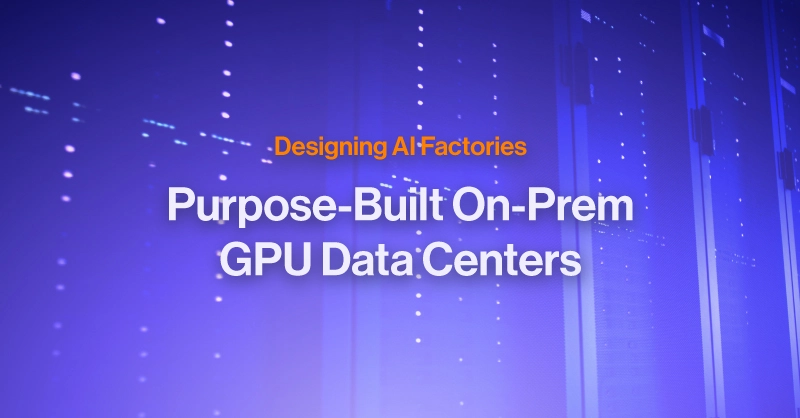
What are AI factories?
AI factories are modern GPU-powered data centers built to create and deploy intelligence at scale. Popularized by NVIDIA, the concept represents a shift from traditional data centers, once focused on storage or virtualization, to purpose-built environments optimized for high-performance AI.
Unlike conventional infrastructure, AI factories are designed for massive model training, real-time inference, and continuous AI pipelines. They handle the extreme compute and networking demands of large language models, foundation models, and latency-sensitive applications.
As businesses push AI into mission-critical products, reliance on cloud services raises concerns about cost, scalability, and data security. This is driving many organizations to adopt on-prem AI factories, either by retrofitting existing facilities or building new ones from the ground up.
What makes an AI factory?
AI factories are purpose-built for large-scale AI workloads, and their architecture reflects that focus. Here are some important AI factory characteristics
- High-density GPU infrastructure: AI workloads demand massive parallel processing. AI factories feature racks drawing 30–60kW or more, packed with GPU systems like NVIDIA HGX and Grace Hopper. Nodes are interconnected to minimize latency and enable large-scale distributed training across thousands of GPUs.
- AI-centric performance metrics: Efficiency isn’t measured in IOPS or CPU utilization but in token throughput—the number of tokens processed per watt, second, or dollar. For inference, tokens per second matter as much today as RPS did for web servers, setting a new performance standard.
- Ultra-fast networking: Technologies like NVLink, NVSwitch, InfiniBand, and PCIe Gen5 deliver high-bandwidth, low-latency communication between GPUs. These fabrics eliminate bottlenecks during multi-node training and ensure synchronization across large clusters.
- Advanced cooling solutions: Heat density in GPU racks makes liquid cooling essential. Direct-to-chip and immersion cooling outperform air by leveraging water’s 30x higher thermal conductivity, keeping GPUs at peak performance under heavy loads.
- Storage and I/O: AI pipelines need extreme I/O performance. NVMe-over-Fabrics and parallel file systems support massive concurrency. Tier your storage strategies, NVMe for highly accessed data and HDD for archival data to help balance speed and cost.
- AI-aware orchestration: Platforms like Kubernetes with GPU operators, Slurm, and NVIDIA Base Command manage large-scale training and inference jobs. Containerization, job scheduling, and automated failover maximize GPU utilization and maintain workload continuity.
- Tooling & monitoring: Implement comprehensive monitoring with thermal sensors, power telemetry, and AI workload dashboards for operational visibility. Integration with DCIM systems provides real-time infrastructure insights, while predictive maintenance algorithms and AI-driven alerts help prevent costly downtime from thermal issues or power fluctuations.
AI factory design in action: Modular, scalable blueprints
Designing a scalable AI factory requires a pragmatic approach that adapts to your organization’s growth trajectory. The following modular blueprints provide a foundation for building AI infrastructure that can evolve from initial experimentation to enterprise-scale deployment. Each configuration represents a logical expansion point, balancing immediate needs with future scalability while minimizing costly retrofits.
- Starter (1 Rack): ~30kW rack, 8–16 GPUs, efficient cooling of choice, fast NVMe storage. This is ideal for most users and for proof-of-concept training and small-scale inference.
- Mid-scale (4 Racks): Add high-speed fabric networking, such as InfiniBand, a parallel file system, and workload orchestration for multi-node training.
- Full scale (20 Racks): Fully redundant power and cooling loops, advanced interconnects, and centralized orchestration for continuous, large-scale AI workloads.
Design for expansion from day one: leave spare rack space, power headroom, and structured cabling for future capacity. Adopt open management and interoperability standards for hardware, networking, and storage to ensure long-term flexibility. Modular rack designs make upgrades simpler and help future-proof the environment.
Cost and ROI: Is building an AI factory worth it?
AI factories require significant upfront investment but can deliver better long-term economics compared to the cloud. Cloud GPUs often cost $3–$10 per GPU-hour, a great starting point, but it snowballs quickly. On-prem systems have a higher upfront cost but can be amortized over 3–5 years to provide predictable costs and better control. Metrics like tokens per second per watt or dollar tie ROI directly to model progress. With an on-prem solution, you have increased control over your hardware. Training an AI model with drastically shortened time-to-market.
On-Prem excels when:
- Security & compliance: Keeps sensitive data local.
- Low-latency inference: Ideal for real-time applications like video analytics or trading.
- Cost at scale: Large, sustained workloads typically favor owned infrastructure.
- Data speed is a priority: Avoids costly, slow data transfers to and from the cloud.
To model ROI, include hardware lifespan, power and cooling costs, workload demand, downtime risk, and cloud egress fees. Factor in GPU resale value, which can remain above 50% after two to three years, to strengthen total cost projections.
The future of AI infrastructure for enterprises
AI factories are no longer exclusive to hyperscalers. Enterprises, universities, and even small and medium businesses can now adopt high-performance design strategies tailored for real-world AI workloads.
With purpose-built on-prem GPU data centers, organizations gain more control over latency, cost, and compliance while unlocking the compute power needed to train and run cutting-edge models. With the widespread AI adoption in all kinds of workloads, every team looking towards their future will need to develop their own custom AI computing infrastructure. The future of AI is in the data centers that power them.
